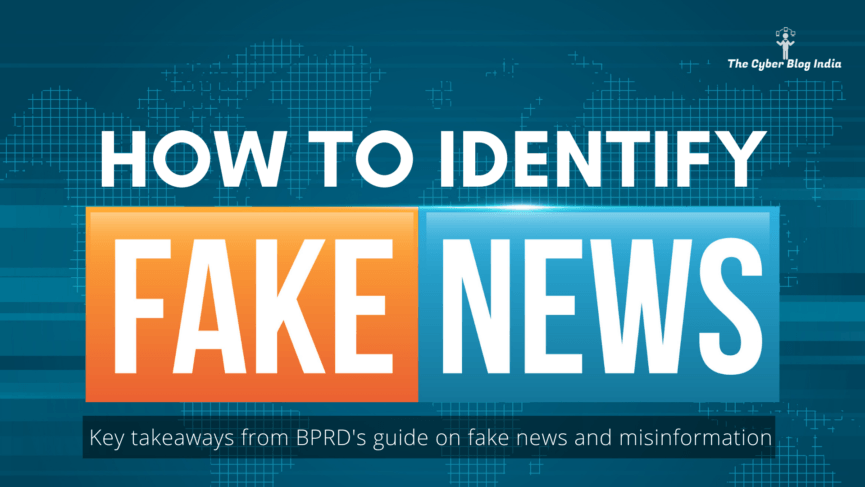How to identify fake news? Key takeaways from BPRD’s Guide

Bureau of Police Research & Development (BPRD)’s National Cyber Research & Innovation Centre (NCR&IC) published a guide for law enforcement agencies on spotting and investigating fake news and misinformation. This 40-page guide was published on May 08, 2020, but it was subsequently removed from the public domain on May 10, 2020. The actual reasons as to why this guide was removed from the public domain are not known. Whatever be the case, this guide had some good takeaways that internet users, like you and me, can follow to identify fake news and misinformation on the internet.
In one of my previous articles, I had discussed how fake news and misinformation spread over social media platforms. You can read this article here. Furthermore, in a crisis situation like COVID-19, fake news and misinformation have definitely made an impact.
Defining Fake News
This guide recognised Wikipedia’s definition of fake news as
A form of news consisting of deliberate disinformation or hoaxes spread via traditional news media (print and broadcast) or online social media.
It also states that “fake news is written and published usually to mislead with the intent to damage an agency, entity, or person, and/or gain financially or politically, often using sensationalist, dishonest, or outright fabricated headlines to increase readership.”
The guide recognises five types of fake news and disinformation vectors:
- Audios
- Videos
- Images/Photos
- Textual Posts
- URLs, Emails, Social Media Apps & Other Digital Platforms
Identification of Fake News
- False Connection: Instances when headlines, visuals, or captions do not support the contents.

An example of False Connection – Part 1

An example of False Connection – Part 2
- False Context: Instances when genuine content is shared with false contextual information.
- Misleading Content: Instances when information linked to an issue/individual is misused.

An example of misleading content
- Impostor Content: Instances when genuine content/sources are impersonated with false/made-up sources

An example of impostor content (Image taken from the guide)
- Fabricated Content: Instances when false news is designed to deceive and harm

An example of fabricated content
- Satire/parody: Instances when there is no intention to cause harm, but the content in question has the potential to fool people

An example of satire/parody
Parameters for Spotting Fake News and Disinformation
The guide indicates the following parameters for the law enforcement agencies to spot fake news and disinformation. We can use these parameters in our day-to-day life to identify whether a piece of information is fake or not.
- Consider the source: Often, messages received on social media/instant messaging platforms contain links that host fake news. They might have spelling and grammatical issues. Look for the signs to check if the information being displayed is accurate.
- Check photos and videos carefully: It is easy to edit photos, videos, and audio recordings. Check the trusted sources to verify if the contents of such photo/video/audio recording are being reported somewhere else as well.
- Read beyond the headlines: Attractive headlines are created as click-baits to attract more clicks. Instead of simply reading the headline, read the whole story.
- Check the author: If the content is hosted on an online platform, search for the author. Check if you can find any reliable sources connected to the same author.
- Supporting sources: If a story has hyperlinks, click on those links to check if the information being displayed is supported by the content available on hyperlinks.
- Check the date of publication: It has been observed that reposting old news/stories in the current context has been a trend. However, old stories might not be relevant to the present context at all.
- Check your biases: If there is a piece of information in the content in question that confirms your pre-existing beliefs, thoroughly review the facts before sharing.
- Verify from other sources: If you are not sure about the correct news about a particular issue, check if the trusted websites are talking about it.
- Understand when a message is forwarded: Every message forwarded on WhatsApp is labelled as “Forwarded.”
Conclusion
Fake news and misinformation spread faster than wildfire. Fake news often goes viral and just because a message has been shared many times, it does not mean that it is true. With a continuously increasing internet penetration rate in India, fake news has the potential to gravely impact individuals as well as the society at large. Mob lynching is a prime example of what fake news might result in. If you have read this article, then as a fellow internet user, I urge you to:
- Think twice before sharing/forwarding any piece of information.
- Don’t simply believe in the headline and avoid the rest.
- If you are not sure if a particular piece of information is correct, verify it.
- And if you see someone who is either sharing or forwarding fake news or misinformation, let them know.
You can read more on this from our friends at Cyber Cops here: How to Spot Real and Fake News in India 2020
